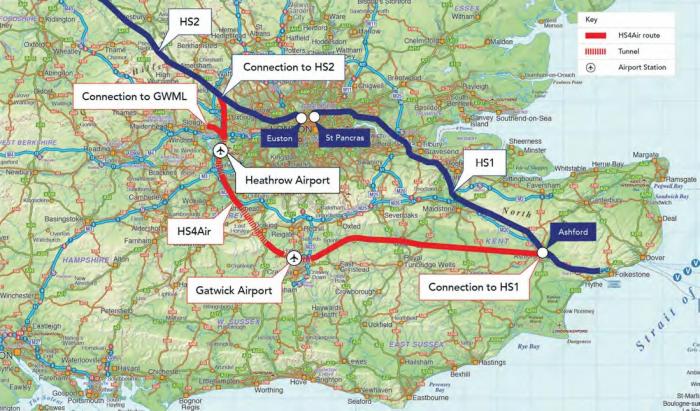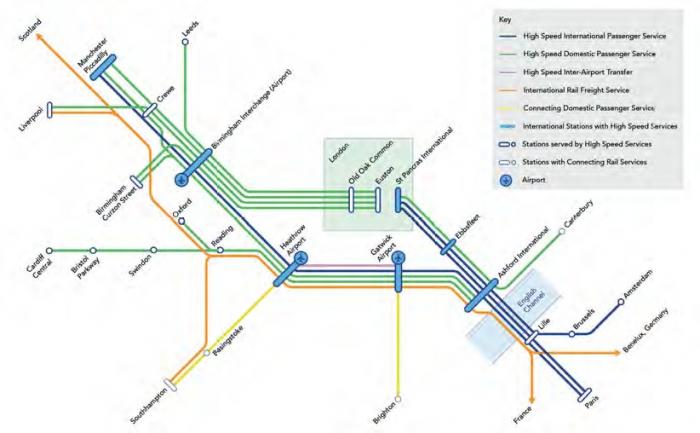HS4AIR LINE WOULD LINK MAJOR LONDON AIRPORTS WITH HS1 & HS2
London-based engineering consultancy Expedition has developed a proposal for a new £10 billion high-speed railway referred to as ‘HS4Air’ (High Speed for Air). The line would connect the existing HS1 rail line to the planned HS2 rail line along a route that passes through both Gatwick (LGW) and Heathrow (LHR) airports to the south and west of London. HS4Air also includes a connection to the Great Western main line (GWML) to the north of Heathrow airport.
BENEFITS
Expedition lists the benefits of the proposed development:
■ Fast direct rail access to both Gatwick and Heathrow airports from major UK cities to the north and west of London. Rail passengers would be able to travel directly to both airports on fast regular services from cities such as Birmingham, Manchester, Leeds and Cardiff without any need to change trains.
■ Dramatically reduced journey times for rail passengers travelling between places south of London and towns and cities in the Midlands, the North and the West. By avoiding the need to travel via central London including multiple changes, journey times from Sussex and Kent to the Midlands and West could be reduced by up to one hour. n Direct international train services from the Midlands and North UK to Europe via the Channel Tunnel. The promoters claim that, compared to journeys by air, high-speed train services to Paris from both Birmingham and Manchester would be faster city centre to city centre.
■ A 15-minute surface transfer shuttle time between Gatwick and Heathrow airports using dedicated high-speed shuttles between airport stations on the HS4Air railway. ‘The fast and frequent shuttle services would make it possible for passengers to make convenient and reliable transfers between Gatwick and Heathrow and for airlines to share operations between the two airports.’
■ Fast rail freight services could bypass London, avoiding the capital’s congested rail networks.
■ By cutting the number of people crossing London, HS4Air would release significant capacity in London’s rail network for use by Londoners.
■ By encouraging a modal shift from road and domestic air to rail, HS4Air would relieve jams on the M25 and ease the pressure on the airports by reducing the number of domestic flights.
EXTERNALITIES
The promoters say there would be other benefits, including reduced carbon emissions and less air pollution as a result of modal shift. National distribution networks for utilities such as power, water and broadband would be able to make use of the proposed HS4Air rail corridor by placing cables and pipes alongside the railway. For example, the National Grid would be able to reinforce its network south of London by placing buried high voltage cables alongside the HS4Air railway lines.
Expedition argues that stronger transport links between the towns and cities in South East England and the rest of the UK (avoiding London) would stimulate economic growth across the entire nation.
ROUTE
The route of the HS4Air high-speed railway is approximately 140km long between its connections with HS1 at Ashford and its proposed connection with HS2 near Denham. From Ashford to Edenbridge the existing railway would be used.
This is the South Eastern’s original boat train route, with the racing stretch east of Tonbridge. Some work on the junction at Tonbridge and refettling would be needed for increased speeds, along with installation of overhead wires; HS4Air says its plans for four extra trains each hour could be accommodated within the existing service pattern.



From Edenbridge to HS2, HS4Air envisages an all-new 320km/h railway, with tunnels under Gatwick, the Surrey Hills Area of Outstanding Natural Beauty and Heathrow and surface construction elsewhere, with much of the surface route alongside the M25.
At Gatwick, a new station box in the car park area to the south east of the existing South Terminal and rail station is proposed. This could have six or even eight platform faces: n two for international services from north of London to the Continent, with security screens;
■ two for high-speed regional services;
■ two for a Gatwick – Heathrow ‘landside’ shuttle;
■ two for an inter-airport ‘airside’ shuttle, allowing international passengers to change planes between Heathrow and Gatwick without any need to pass through immigration.
The latter two services could be combined. Separate landside and airside units splitting and joining outside the stations, or using different zones of the platforms, are possibilities. Up to six trains per hour between the two airports are envisaged.
At Heathrow, the HS4Air station would be on a north-south alignment west of the existing T5 station. A link to the Great Western main line at Langley would obviate any need for the western rail link to Heathrow project, allowing Inter-city Express Trains to reach the airports.
The continuation northwards to join with HS2 near Denham would replace the scrapped HS2 to Heathrow spur. The link to HS1 at Ashford would allow high-speed trains from the North to reach the Continent, replacing the ‘mousehole’ single-track tunnel under Camden that was proposed between HS2 and HS1 and later abandoned.
Two pairs of passing loops are envisaged between Ashford and Denham, to allow night-time use of the route by high-speed freight trains. HS4Air is the brainchild of ‘Boris Island’ architect Alistair Lenczner, an Expedition director since 2014 and a chartered engineer with over 35 years’ experience in the design of major infrastructure projects.
Before joining Expedition, he spent 16 years at Foster + Partners, where he was instrumental in the design development of the proposed Thames Hub project which included a new airport in the inner Thames estuary.
Mr Lenczner says: ‘By providing nationwide high-speed rail access direct into the country’s most important airports, HS4Air achieves the type of rail/aviation transport network integration that already exists in neighbouring European countries such as France (Paris CDG), Germany (Frankfurt), Netherlands (Schiphol), Belgium (Brussels National) and Switzerland (Zurich)’.
The HS4Air proposal had its genesis prior to the Government’s ‘market-led proposals’ initiative, but Mr Lenczner says it fits in with the Government’s vision. ‘It’s sparked an interest with sovereign wealth funds and pension funds’ he adds.
